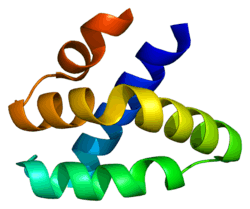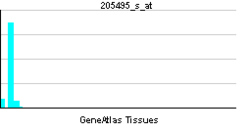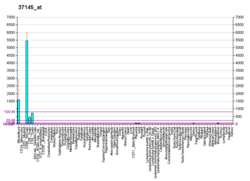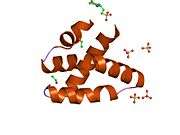GNLY
Granulysin, also known as GNLY, is a protein which in humans is encoded by the GNLY gene.[3] It is also known as NK-lysin (NKL) after NK cells;[4] the cattle ortholog is sometimes referred to as Bo-lysin.
| GNLY | |||||||||||||||||||||||||
|---|---|---|---|---|---|---|---|---|---|---|---|---|---|---|---|---|---|---|---|---|---|---|---|---|---|
 | |||||||||||||||||||||||||
| |||||||||||||||||||||||||
| Identifiers | |||||||||||||||||||||||||
| Aliases | GNLY, 519, D2S69E, LAG-2, LAG2, NKG5, TLA519, granulysin | ||||||||||||||||||||||||
| External IDs | OMIM: 188855 HomoloGene: 136805 GeneCards: GNLY | ||||||||||||||||||||||||
| |||||||||||||||||||||||||
| |||||||||||||||||||||||||
| Orthologs | |||||||||||||||||||||||||
| Species | Human | Mouse | |||||||||||||||||||||||
| Entrez |
| ||||||||||||||||||||||||
| Ensembl |
| ||||||||||||||||||||||||
| UniProt |
| ||||||||||||||||||||||||
| RefSeq (mRNA) |
| ||||||||||||||||||||||||
| RefSeq (protein) |
| ||||||||||||||||||||||||
| Location (UCSC) | Chr 2: 85.69 – 85.7 Mb | n/a | |||||||||||||||||||||||
| PubMed search | [2] | n/a | |||||||||||||||||||||||
| Wikidata | |||||||||||||||||||||||||
| |||||||||||||||||||||||||
Granulysin is released by cytotoxic T cells and NK cells when they are attached to infected body cells. It creates holes in the target cell membrane and destroy it. Granulysin is able to induce apoptosis in target cells and also has antimicrobial action. Granulysin is broadly antimicrobial, killing microbes that cause, for example, tuberculosis and malaria, and can destroy some tumors.[5] A series of peptides generated from the amino acid sequence of granulysin are potential antibiotics.
Function
Granulysin is a protein present in cytolytic granules of cytotoxic T cells (CD8+) and natural killer cells along with perforin and granzymes. Granulysin is a member of the saposin-like protein (SAPLIP) family and is released from cytotoxic T cells upon antigen stimulation. Granulysin has antimicrobial activity against M. tuberculosis and other organisms. Granulysin is alternatively spliced, resulting in the NKG5 and 519 transcripts.[3]
Granulysin is a cytolytic and proinflammatory molecule first identified by a subtractive hybridization screen for genes expressed “late” (3–5 days) after activation of human peripheral blood mononuclear cells.[6] Granulysin is present in cytolytic granules of cytotoxic T lymphocytes (CTL) and natural killer (NK) cells. Granulysin is made as a 15 kD molecule, and a portion of it is cleaved at both the amino and carboxy termini into a 9 kD form. The 9 kD form is released by receptor-mediated granule exocytosis while the 15 kD form is constitutively secreted. Recombinant 9 kD granulysin is broadly cytolytic against tumors and microbes, including gram positive and gram negative bacteria, fungi/yeast and parasites.[7] 9kD granulysin is also a chemoattractant for T lymphocytes, monocytes, and other inflammatory cells and activates the expression of a number of cytokines, including RANTES, MCP-1, MCP-3, MIP-1α, IL-10, IL-1, IL-6 and IFNα.[8] Granulysin has been implicated in a myriad of diseases including infection, cancer, transplantation, autoimmunity, skin and reproductive maladies.[9]
Granulysin has recently been implicated in the development of Stevens-Johnson Syndrome.
Evolution
GNLY orthologs have been identified in multiple species, including pigs, chicken, and cattle. Cattle has multiple copies of the gene with functional diversification.[10]
Mice do not have a granulysin homolog, but transgenic mice expressing human granulysin have been engineered.[11]
References
- GRCh38: Ensembl release 89: ENSG00000115523 - Ensembl, May 2017
- "Human PubMed Reference:". National Center for Biotechnology Information, U.S. National Library of Medicine.
- "Entrez Gene: GNLY granulysin".
- Andersson M, Gunne H, Agerberth B, Boman A, Bergman T, Sillard R, Jörnvall H, Mutt V, Olsson B, Wigzell H (April 1995). "NK-lysin, a novel effector peptide of cytotoxic T and NK cells. Structure and cDNA cloning of the porcine form, induction by interleukin 2, antibacterial and antitumour activity". The EMBO Journal. 14 (8): 1615–25. PMC 398254. PMID 7737114.
- Janeway, Charles (2005). Immunobiology: the immune system in health and disease (6th ed.). New York: Garland Science. ISBN 978-0-8153-4101-7.
- Jongstra J, Schall TJ, Dyer BJ, Clayberger C, Jorgensen J, Davis MM, Krensky AM (March 1987). "The isolation and sequence of a novel gene from a human functional T cell line". The Journal of Experimental Medicine. 165 (3): 601–14. doi:10.1084/jem.165.3.601. PMC 2188281. PMID 2434598.
- Stenger S, Hanson DA, Teitelbaum R, Dewan P, Niazi KR, Froelich CJ, Ganz T, Thoma-Uszynski S, Melián A, Bogdan C, Porcelli SA, Bloom BR, Krensky AM, Modlin RL (October 1998). "An antimicrobial activity of cytolytic T cells mediated by granulysin". Science. 282 (5386): 121–5. doi:10.1126/science.282.5386.121. PMID 9756476.
- Deng A, Chen S, Li Q, Lyu SC, Clayberger C, Krensky AM (May 2005). "Granulysin, a cytolytic molecule, is also a chemoattractant and proinflammatory activator". Journal of Immunology. 174 (9): 5243–8. doi:10.4049/jimmunol.174.9.5243. PMID 15843520.
- Krensky AM, Clayberger C (March 2009). "Biology and clinical relevance of granulysin". Tissue Antigens. 73 (3): 193–8. doi:10.1111/j.1399-0039.2008.01218.x. PMC 2679253. PMID 19254247.
- Chen J, Huddleston J, Buckley RM, Malig M, Lawhon SD, Skow LC, Lee MO, Eichler EE, Andersson L, Womack JE (December 2015). "Bovine NK-lysin: Copy number variation and functional diversification". Proceedings of the National Academy of Sciences of the United States of America. 112 (52): E7223–9. doi:10.1073/pnas.1519374113. PMC 4702975. PMID 26668394.
- Huang LP, Lyu SC, Clayberger C, Krensky AM (January 2007). "Granulysin-mediated tumor rejection in transgenic mice". Journal of Immunology. 178 (1): 77–84. doi:10.4049/jimmunol.178.1.77. PMC 2664664. PMID 17182542.
- Krista Conger. Grant to fund research into preventing bioterrorism, Stanford Report, November 12, 2003.
- Stenger S, Hanson DA, Teitelbaum R, et al. (October 1998). "An antimicrobial activity of cytolytic T cells mediated by granulysin". Science. 282 (5386): 121–5. doi:10.1126/science.282.5386.121. PMID 9756476.
- Peña SV, Hanson DA, Carr BA, Goralski TJ, Krensky AM (March 1997). "Processing, subcellular localization, and function of 519 (granulysin), a human late T cell activation molecule with homology to small, lytic, granule proteins". J. Immunol. 158 (6): 2680–8. PMID 9058801.
- Krensky AM, Clayberger C (August 2005). "Granulysin: a novel host defense molecule". Am. J. Transplant. 5 (8): 1789–92. doi:10.1111/j.1600-6143.2005.00970.x. PMID 15996224.
- Walch, Michael; Dotiwala, Farokh; Mulik, Sachin; Thiery, Jerome; Kirchhausen, Tomas; Clayberger, Carol; Krensky, Alan M.; Martinvalet, Denis; Lieberman, Judy (June 2014). "Cytotoxic Cells Kill Intracellular Bacteria through Granulysin-Mediated Delivery of Granzymes". Cell. 157 (6): 1309–1323. doi:10.1016/j.cell.2014.03.062. PMC 4090916. PMID 24906149.
- da Silva AP, Unks D, Lyu SC, et al. (May 2008). "In vitro and in vivo antimicrobial activity of granulysin-derived peptides against Vibrio cholerae". J. Antimicrob. Chemother. 61 (5): 1103–9. doi:10.1093/jac/dkn058. PMC 2664651. PMID 18310138.
- Chung WH, Hung SI, Yang JY, Su SC, Huang SP, Wei CY, Chin SW, Chiou CC, Chu SC, Ho HC, Yang CH, Lu CF, Wu JY, Liao YD, Chen YT (Dec 2008). "Granulysin is a key mediator for disseminated keratinocyte death in Stevens-Johnson syndrome and toxic epidermal necrolysis". Nat. Med. 14 (12): 1343–50. doi:10.1038/nm.1884. PMID 19029983.
Further reading
- Peña SV, Krensky AM (April 1997). "Granulysin, a new human cytolytic granule-associated protein with possible involvement in cell-mediated cytotoxicity". Seminars in Immunology. 9 (2): 117–25. doi:10.1006/smim.1997.0061. PMID 9194222.
- Krensky AM (February 2000). "Granulysin: a novel antimicrobial peptide of cytolytic T lymphocytes and natural killer cells". Biochemical Pharmacology. 59 (4): 317–20. doi:10.1016/S0006-2952(99)00177-X. PMID 10644038.
- Donlon TA, Krensky AM, Clayberger C (1990). "Localization of the human T lymphocyte activation gene 519 (D2S69E) to chromosome 2p12----q11". Cytogenetics and Cell Genetics. 53 (4): 230–1. doi:10.1159/000132938. PMID 2209093.
- Yabe T, McSherry C, Bach FH, Houchins JP (October 1990). "A cDNA clone expressed in natural killer and T cells that likely encodes a secreted protein". The Journal of Experimental Medicine. 172 (4): 1159–63. doi:10.1084/jem.172.4.1159. PMC 2188624. PMID 2212946.
- Jongstra J, Schall TJ, Dyer BJ, Clayberger C, Jorgensen J, Davis MM, Krensky AM (March 1987). "The isolation and sequence of a novel gene from a human functional T cell line". The Journal of Experimental Medicine. 165 (3): 601–14. doi:10.1084/jem.165.3.601. PMC 2188281. PMID 2434598.
- Houchins JP, Kricek F, Chujor CS, Heise CP, Yabe T, McSherry C, Bach FH (1993). "Genomic structure of NKG5, a human NK and T cell-specific activation gene". Immunogenetics. 37 (2): 102–7. doi:10.1007/BF00216832. PMID 8423048.
- Peña SV, Hanson DA, Carr BA, Goralski TJ, Krensky AM (March 1997). "Processing, subcellular localization, and function of 519 (granulysin), a human late T cell activation molecule with homology to small, lytic, granule proteins". Journal of Immunology. 158 (6): 2680–8. PMID 9058801.
- Stenger S, Hanson DA, Teitelbaum R, Dewan P, Niazi KR, Froelich CJ, Ganz T, Thoma-Uszynski S, Melián A, Bogdan C, Porcelli SA, Bloom BR, Krensky AM, Modlin RL (October 1998). "An antimicrobial activity of cytolytic T cells mediated by granulysin". Science. 282 (5386): 121–5. doi:10.1126/science.282.5386.121. PMID 9756476.
- Hanson DA, Kaspar AA, Poulain FR, Krensky AM (May 1999). "Biosynthesis of granulysin, a novel cytolytic molecule". Molecular Immunology. 36 (7): 413–22. doi:10.1016/S0161-5890(99)00063-2. PMID 10449094.
- Kaspar AA, Okada S, Kumar J, Poulain FR, Drouvalakis KA, Kelekar A, Hanson DA, Kluck RM, Hitoshi Y, Johnson DE, Froelich CJ, Thompson CB, Newmeyer DD, Anel A, Clayberger C, Krensky AM (July 2001). "A distinct pathway of cell-mediated apoptosis initiated by granulysin". Journal of Immunology. 167 (1): 350–6. doi:10.4049/jimmunol.167.1.350. PMID 11418670.
- Kitamura N, Koshiba M, Horie O, Ryo R (2002). "Expression of granulysin mRNA in the human megakaryoblastic leukemia cell line CMK". Acta Haematologica. 108 (1): 13–8. doi:10.1159/000063061. PMID 12145461.
- Ma LL, Spurrell JC, Wang JF, Neely GG, Epelman S, Krensky AM, Mody CH (November 2002). "CD8 T cell-mediated killing of Cryptococcus neoformans requires granulysin and is dependent on CD4 T cells and IL-15". Journal of Immunology. 169 (10): 5787–95. doi:10.4049/jimmunol.169.10.5787. PMID 12421959.
- Ericson KG, Fadeel B, Andersson M, Gudmundsson GH, Gürgey A, Yalman N, Janka G, Nordenskjöld M, Henter JI (January 2003). "Sequence analysis of the granulysin and granzyme B genes in familial hemophagocytic lymphohistiocytosis". Human Genetics. 112 (1): 98–9. doi:10.1007/s00439-002-0841-0. PMID 12483306.
- Anderson DH, Sawaya MR, Cascio D, Ernst W, Modlin R, Krensky A, Eisenberg D (January 2003). "Granulysin crystal structure and a structure-derived lytic mechanism". Journal of Molecular Biology. 325 (2): 355–65. CiteSeerX 10.1.1.327.5540. doi:10.1016/S0022-2836(02)01234-2. PMID 12488100.
- Gansert JL, Kiessler V, Engele M, Wittke F, Röllinghoff M, Krensky AM, Porcelli SA, Modlin RL, Stenger S (March 2003). "Human NKT cells express granulysin and exhibit antimycobacterial activity". Journal of Immunology. 170 (6): 3154–61. doi:10.4049/jimmunol.170.6.3154. PMID 12626573.
- Ogawa K, Takamori Y, Suzuki K, Nagasawa M, Takano S, Kasahara Y, Nakamura Y, Kondo S, Sugamura K, Nakamura M, Nagata K (July 2003). "Granulysin in human serum as a marker of cell-mediated immunity". European Journal of Immunology. 33 (7): 1925–33. doi:10.1002/eji.200323977. PMID 12884856.
- Kotsch K, Mashreghi MF, Bold G, Tretow P, Beyer J, Matz M, Hoerstrup J, Pratschke J, Ding R, Suthanthiran M, Volk HD, Reinke P (June 2004). "Enhanced granulysin mRNA expression in urinary sediment in early and delayed acute renal allograft rejection". Transplantation. 77 (12): 1866–75. doi:10.1097/01.TP.0000131157.19937.3F. PMID 15223905.




